形容词和副词的用法考前快速复习
初中的归纳常见的形容词与副词的用法总结

初中的归纳常见的形容词与副词的用法总结形容词和副词在英语中扮演着非常重要的角色,它们可以描述事物的特征和状态,使我们的表达更加生动和具体。
在初中阶段,学生们需要掌握常见的形容词和副词的用法,以便更好地写作和表达自己的想法。
下面是一些常见的形容词和副词的用法总结。
一、形容词的用法1. 形容词的位置形容词通常位于名词之前,用来描述名词的特征或性质。
例如:- a beautiful flower(一朵美丽的花)- an interesting book(一本有趣的书)2. 形容词作表语形容词也可以作为表语,用来描述主语的特征或状态。
例如:- The weather is sunny today.(今天天气晴朗。
)- She seems tired.(她看起来很累。
)3. 形容词的比较级和最高级形容词可以根据程度的不同,用比较级和最高级来表示。
比较级用于两个事物的比较,最高级用于三个或三个以上事物的比较。
例如:- This book is more interesting than that one.(这本书比那本书更有趣。
)- English is the most widely spoken language in the world.(英语是世界上使用最广泛的语言。
)二、副词的用法1. 副词的位置副词通常位于动词之前,用来修饰动作的方式、程度或频率。
例如:- He runs fast.(他跑得快。
)- She speaks English fluently.(她流利地讲英语。
)2. 副词作状语副词可以作为状语,用来描述动词、形容词或其他副词的方式、程度或频率。
例如:- He sings loudly.(他大声唱歌。
)- The car is too expensive.(这辆车太贵了。
)3. 副词的比较级和最高级副词的比较级和最高级的形式和用法与形容词类似。
例如:- She runs faster than her brother.(她跑得比她哥哥快。
形容词和副词的用法口诀
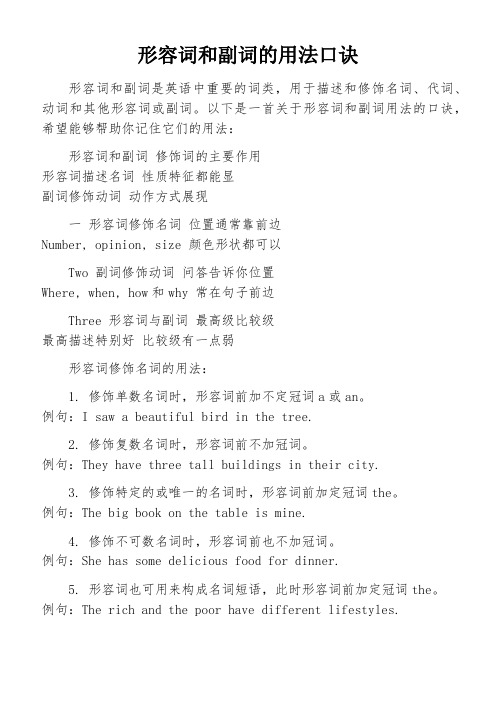
形容词和副词的用法口诀形容词和副词是英语中重要的词类,用于描述和修饰名词、代词、动词和其他形容词或副词。
以下是一首关于形容词和副词用法的口诀,希望能够帮助你记住它们的用法:形容词和副词修饰词的主要作用形容词描述名词性质特征都能显副词修饰动词动作方式展现一形容词修饰名词位置通常靠前边Number, opinion, size 颜色形状都可以Two 副词修饰动词问答告诉你位置Where, when, how和why 常在句子前边Three 形容词与副词最高级比较级最高描述特别好比较级有一点弱形容词修饰名词的用法:1. 修饰单数名词时,形容词前加不定冠词a或an。
例句:I saw a beautiful bird in the tree.2. 修饰复数名词时,形容词前不加冠词。
例句:They have three tall buildings in their city.3. 修饰特定的或唯一的名词时,形容词前加定冠词the。
例句:The big book on the table is mine.4. 修饰不可数名词时,形容词前也不加冠词。
例句:She has some delicious food for dinner.5. 形容词也可用来构成名词短语,此时形容词前加定冠词the。
例句:The rich and the poor have different lifestyles.6. 形容词还可以加上后缀-er和-est构成比较级和最高级形式。
例句:She is taller than her sister. (比较级)He is the tallest boy in the class. (最高级)副词修饰动词的用法:1. 副词通常放在动词之后。
例句:He runs quickly in the morning.2. 若要强调副词修饰的是动作的方式,将副词置于句首。
例句:Quickly, he finished his homework.3. 副词也可以修饰整个句子,放在句子前或句子末。
高考英语复习形容词和副词知识点讲解讲义(必考点)
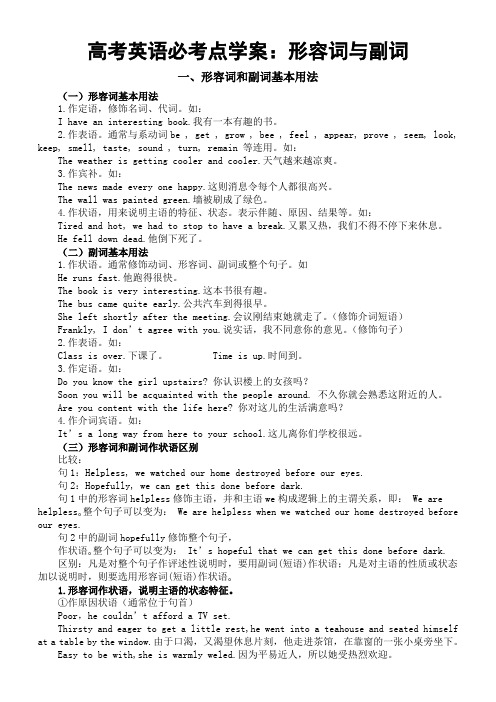
高考英语必考点学案:形容词与副词一、形容词和副词基本用法(一)形容词基本用法1.作定语,修饰名词、代词。
如:I have an interesting book.我有一本有趣的书。
2.作表语。
通常与系动词be , get , grow , bee , feel , appear, prove , seem, look, keep, smell, taste, sound , turn, remain 等连用。
如:The weather is getting cooler and cooler.天气越来越凉爽。
3.作宾补。
如:The news made every one happy.这则消息令每个人都很高兴。
The wall was painted green.墙被刷成了绿色。
4.作状语,用来说明主语的特征、状态。
表示伴随、原因、结果等。
如:Tired and hot, we had to stop to have a break.又累又热,我们不得不停下来休息。
He fell down dead.他倒下死了。
(二)副词基本用法1.作状语。
通常修饰动词、形容词、副词或整个句子。
如He runs fast.他跑得很快。
The book is very interesting.这本书很有趣。
The bus came quite early.公共汽车到得很早。
She left shortly after the meeting.会议刚结束她就走了。
(修饰介词短语)Frankly, I don’t agree with you.说实话,我不同意你的意见。
(修饰句子)2.作表语。
如:Class is over.下课了。
Time is up.时间到。
3.作定语。
如:Do you know the girl upstairs? 你认识楼上的女孩吗?Soon you will be acquainted with the people around. 不久你就会熟悉这附近的人。
2024年中考英语专项复习课件形容词和副词专项复习

即时训练
1.(2023•山西)His mom and dad _u_s_u_a_ll_y_ (usual) enjoy his food. 2.(2023•山西)However, our actions make many kinds of animals in danger, and we treat millions of animals __b_ad_l_y_ (bad). 3.(2022•山西) _S_u_rp_r_is_in_g_ly_ (surprising), all my group members ended up doing their part. 4.(2023•太原一模)In fact, in the movie, there are some _t_ru_l_y_ (true) heartbreaking moments as well as some heartwarming ones. 5.She studies English very hard and speaks English _r_e_a_lly__(real) fluently.
形容词和副词 专项复习
形容词
●1.句法功能
作表语
用法 常用_系__动__词__在后面
示例 She is friendly. The meat tastes delicious.
用法
示例
一般用在_名__词_____之前
She is a beautiful girl.
作定语 用在_不__定__代__词___之后(形容词作
support. 7.(2023•太原一模)Last but not the least, remember to wait out the storm. That is to say, it is _d_an_g_e_r_o_u_s (dander) to move
小升初重要知识点整理常见形容词与副词用法总结

小升初重要知识点整理常见形容词与副词用法总结在小升初备考过程中,掌握好形容词与副词的用法是非常重要的。
形容词与副词的正确运用,不仅能够提升文章的表达能力,还能够增加语句的准确性和语感。
下面是小升初常见的形容词与副词用法总结。
一、常见形容词的用法:1. 形容词修饰名词:例句:这只小猫很可爱。
2. 形容词修饰不定代词或疑问代词:例句:几个小孩在笑。
3. 形容词修饰主语时,可以使用主动形式表示主语的特征:例句:他们主动帮助了别人。
4. 形容词修饰物体时,可以使用被动形式表示物体的状态:例句:这个箱子被打开了。
5. 形容词修饰名词时,可以使用比较级和最高级:例句:这本书比那本书更有趣。
6. 形容词修饰名词时,可以使用形容词的反义词:例句:这位老师很和蔼,对学生很严厉。
二、常见副词的用法:1. 副词修饰动词:例句:他慢慢地走了过来。
2. 副词修饰形容词:例句:他非常高兴。
3. 副词修饰副词:例句:她非常非常聪明。
4. 副词修饰整个句子,表示说话者的观点或态度:例句:幸运地,我们考试取得了好成绩。
5. 副词修饰动词时,可以使用副词的比较级和最高级:例句:他跑得比谁都快。
6. 副词修饰形容词时,可以使用副词的反义词:例句:这件事情非常不错,值得肯定。
以上是小升初备考中常见的形容词与副词用法总结。
掌握好这些规则,在写作和作文中就能够运用自如。
通过大量的练习,良好的语感和准确的表达能力也会逐渐形成。
希望能对同学们的备考有所帮助!。
中考英语形容词与副词复习

中考英语形容词与副词复习篇一:2016年中考英语复习之形容词(副词)2016年中考英语复习之形容词(副词)一、形容词/副词的用法 1.用来修饰名词作定语;2.位于主系表结构中作表语;(常见的系动词有:一是一感一保持, 起来四个好像变了三。
)be,feel,stay,keep,look,smell,taste,sound,seem,turn,bee ,get3.有的形容词只能做表语(lonely,afraid,asleep,awake,alive)4.做宾语补足语,对句子的宾语进行补充说明 We should keep our classroom clean.5.副词用来修饰动词或形容词。
二、常见名词变形容词的方法:在名词后加上(表示天气的)y,(表示方位的)ern,(表示称谓的)ly,(表示物质的)en,(表示抽象意义的)ful/less,(表示大洲与国家的)ncloudy,windy,rainy,sunny,foggy,icy,wertern,eastern,sou thern,northern,friendly,motherly,weekly,daily,wooden,g olden,careful,useful,wonderful,colorful,hopeful,succes sful,lucky,hopeless,useless,careless,Asian,American三、表示情感的表语形容词后可接不定式be+glad/happy.pleased/sorrry,sad/sure/kind/ready/afrai d/able/easy/difficult+to do sth四、形容词(副词)比较级、最高级的构成(一)以er,ow,ble,ple,y结尾的双音节词和单音节词:①一般在词尾直接加er或est; ②以不发音的e结尾的, 在词尾加r 或st;③以“辅音字母+y”结尾,先把y变为i,再加er或est; ④.以重读闭音节结尾,且末尾只有一个辅音字母的,双写末尾的辅音字母,再加er/est.fat,thin,sad,hot,big,red,wet.(二)末尾不是以er,ow,ble,ple,y结尾的双音节词和所有多音节词直接在单词前加more/most; (三)以-ly结尾的副词和以-ing/-ed结尾的形容词直接在单词前加more/most; (四)不规则变化(good/well,many/much,bad/badly/ill,little,far,old)good/well-better-best many/much-more/most little-less-leastbad/badly/ill-worse-worst far-farther/further-farthest/furthest old-older/elder-oldest/eldest五、形容词/副词原级的用法1.可以用quite,very,so,too,enough修饰原级;2. as+原级+as3. not+as/so+原级+as4.甲是乙的几倍(甲+is+倍数+as…as+乙)This bridge is three times as long as that one. Your room is twice as large as mine.六、形容词/副词比较级的用法 1.than是比较级的标志词2.句中出现两个比较对象或含两个人/物时,用比较级;3. much,far,even,a little,a lot,a bit常用于比较级之前;4.Which/Who+比较级,A or B?5.甲+be+the+比较级+of the two(甲是两者中较…的)6.甲+be+比较级+than+any other+单数名词(甲比其它的任何一个都…)7.倍数+比较级+than(表示几倍于) This classroom is two times bigger than that one. 8.比较级+and+比较级(越来越…)a.单音节词和以er,ow,ble,ple,y结尾的双音节词:比较级+and+比较级 b.部分双音节词和多音节词:more and more+多音节词原形 9.the+比较级……,the+比较级……(越……,就越……)七、形容词/副词最高级的用法 1.the 是最高级的标志词;2.句中出现≥3个比较对象时,用最高级;3.句中出现of all,of the three,that I have ever seen 时,用最高级;4.Which/Who+is+the+最高级,甲、乙or 丙?5.表示最……之一,要用“one of+the+形容词最高级+复数名词+表示范围的介词短语”6.序数词后的形容词一般要用最高级(表示第几最……) The Yello w River is the second longest river in China.7.形容词最高级前一般要加the,但若最高级前出现了形容词性物主代词或名词所有格形式,则不再用the.8.副词最高级前一般不用定冠词the.翻译下列短语和句子:1.越来越胖2.越来越漂亮3.越来越热4.越来越无聊5.越来越瘦6.越来越高兴7.越来越生气8.越来越饿9.越来越伤心10.越来越冷 11.越来越大12.越来越粗心 13.越来越早 14.越来越多15.越来越好 16.越来越危险17.越来越少18.越来越疲惫19.你越认真,你犯的错误就越少。
形容词副词的用法归纳总结

形容词副词的用法归纳总结形容词和副词是英语中非常重要的词性,它们在句子中起到修饰和描述的作用。
以下是形容词和副词的用法归纳总结:一、形容词的用法1. 作定语:形容词通常用于修饰名词或代词,位于所修饰的名词或代词之前。
例如:a beautiful flower,the smart boy。
2. 作表语:形容词可以用于系动词之后,构成“主系表”结构,描述主语的特征或状态。
例如:She is beautiful. The food tastes good.3. 作宾语补足语:形容词可以用于某些动词的宾语之后,补充说明宾语的特征或状态。
例如:We made the room clean. Please keep the door open.4. 比较级和最高级:形容词可以通过比较级和最高级的形式来进行比较。
比较级用于两者之间的比较,最高级用于三者或以上的比较。
例如:bigger,the biggest。
二、副词的用法1. 修饰动词:副词通常用于修饰动词,描述动作的方式、程度、时间等。
例如:She sings beautifully. He runs fast.2. 修饰形容词:副词也可以用于修饰形容词,增强形容词的描述效果。
例如:very beautiful,extremely smart。
3. 修饰其他副词:副词还可以用于修饰其他副词,进一步说明其程度或方式。
例如:He speaks very loudly.4. 时间和地点副词:副词可以表示时间和地点,如:now,yesterday,here,there。
5. 疑问副词和连接副词:疑问副词用于疑问句中,如:when,where,how;连接副词用于连接句子或从句,如:therefore,however。
需要注意的是,形容词和副词的用法比较灵活,具体使用要根据句子的结构和上下文来决定。
同时,也要注意形容词和副词的比较级和最高级的构成规则以及使用方法。
希望这些总结对你有所帮助。
副词与形容词的用法

精心整理副词和形容词一、形容词的用法1.形容词修饰名词,并且放在名词的前面,这时形容词在句子中作定语例如:a beautiful lady、a tall man、a big houseA beautiful ladyisstandinginfrontofa tall man.2.形容词放在be动词的后面,这时形容词在句子中作表语/主语补足语。
例如:Theladyis tall.(tall在句子中作表语,说明lady是怎么样的)The beautiful ladyis tall.(beautiful在句子中作定语,tall作表语)3.看起来、/主二、1.2.在小即:veryhandsome的中心词是handsome3.副词前面也可以加副词,例如上面的句子都可以改写成:Themanruns veryfast.Shejumps veryhigh.Hefinishedhishomework veryquickly.very本身是副词,意思是“非常,很”,所以后面也可以跟副词或者形容词。
三、填形容词还是副词?动词后面一般都跟副词,但不是所有动词后面都跟副词,实义动词后面跟副词,连系动词后面跟形容词。
.例如:Shesingsbeautifully.(sing是实义动词,beautiful用来说明唱得如何)Tomdrawswell.(draw是实义动词,well用来说明画得如何)Myteacherisyoungandtall.(is是系动词,后面跟形容词)Shelookssad.(look是连系动词,后面跟形容词)**还有一些不是连系动词的词,例如make和get,要根据句子的意思判断填形容词还是副词。
区分:Heismakingakite carefully.(carefully用来修饰make这个动词)Hemadetheteacher angry.(angry是指theteacher,而不是修饰make这个动词) Thestudentgot quiet whentheteachercamein.(quiet是指thestudent,而不是修饰got 这个动词)Igetup early.(early修饰动词getup)Sheleavestheroom quickly.(quickly修饰leave这个动词)Pleaseleavethedoor open.(open是指thedoor,而不是修饰leave这个动词)于是有词组:makesb+adj.leavesb+adj.get+adj因此,填形容词还是副词,首先要弄清楚句子的意思,判断所修饰的成分是名词/代词还是动词,修饰前者的用形容词,修饰后者的用副词。
形容词和副词的知识点归纳
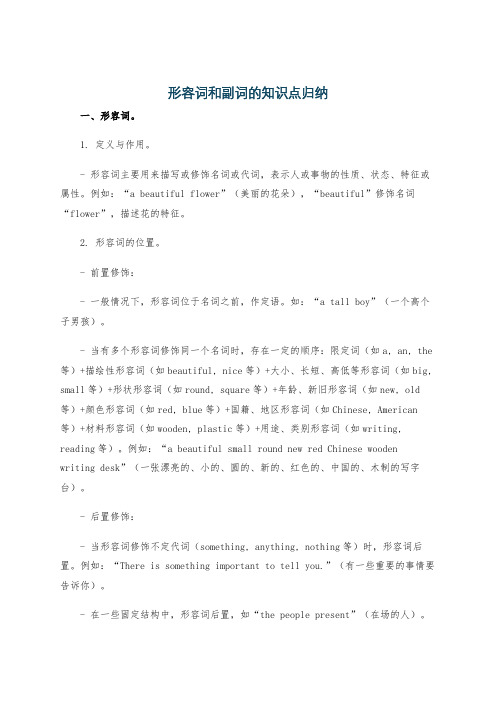
形容词和副词的知识点归纳一、形容词。
1. 定义与作用。
- 形容词主要用来描写或修饰名词或代词,表示人或事物的性质、状态、特征或属性。
例如:“a beautiful flower”(美丽的花朵),“beautiful”修饰名词“flower”,描述花的特征。
2. 形容词的位置。
- 前置修饰:- 一般情况下,形容词位于名词之前,作定语。
如:“a tall boy”(一个高个子男孩)。
- 当有多个形容词修饰同一个名词时,存在一定的顺序:限定词(如a, an, the 等)+描绘性形容词(如beautiful, nice等)+大小、长短、高低等形容词(如big, small等)+形状形容词(如round, square等)+年龄、新旧形容词(如new, old 等)+颜色形容词(如red, blue等)+国籍、地区形容词(如Chinese, American 等)+材料形容词(如wooden, plastic等)+用途、类别形容词(如writing, reading等)。
例如:“a beautiful small round new red Chinese woodenwriting desk”(一张漂亮的、小的、圆的、新的、红色的、中国的、木制的写字台)。
- 后置修饰:- 当形容词修饰不定代词(something, anything, nothing等)时,形容词后置。
例如:“There is something important to tell you.”(有一些重要的事情要告诉你)。
- 在一些固定结构中,形容词后置,如“the people present”(在场的人)。
3. 形容词的比较级和最高级。
- 规则变化:- 一般在词尾加 -er(比较级)和 -est(最高级)。
如:tall - taller - tallest。
- 以不发音的e结尾的单词,加 -r和 -st。
如:nice - nicer - nicest。
初中英语形容词与副词辨析及高效学习方法

初中英语形容词与副词辨析及高效学习方法
初中阶段学习英语,形容词和副词是基础且重要的语法知识。
正确理解和运用形容词与副词,不仅可以提高语言表达的准确性,还能增强语言的表现力。
本文将介绍形容词与副词的辨析,并提供高效学习方法,帮助初中生更好地掌握这一知识点。
形容词与副词辨析
形容词
形容词通常用来描述名词的特征或性质,修饰名词,起到修饰和限定名词的作用。
比如:-美好的一天(描述名词“一天”的特征)-这是漂亮的花(修饰名词“花”)
副词
副词通常用来修饰动词、形容词、其他副词或全句,表示时间、地点、程度、方式等概念。
比如:-她快速地跑过来(修饰动词“跑”)-他非常聪明(修饰形容词“聪明”)
高效学习方法
1.词性转换练习
练习将形容词转换为副词,或副词转换为形容词,加深对它们的理解和运用能力。
2.语境搭配
在句子中正确使用形容词和副词,理解不同语境下它们的含义和用法。
3.记忆技巧
使用记忆卡片、语境联想等方法帮助记忆形容词和副词,提升记忆效率。
4.实践运用
多阅读英语文章、书籍,积累形容词和副词的正确用法,同时勤加练习,提高语言表达能力。
初中英语形容词与副词的辨析是学习英语语法的基础,通过系统学习和实践,可以更好地掌握这一知识点,提高语言运用能力。
形容词和副词在英语学习中扮演着重要角色,正确掌握它们的区别和用法对于提高语言表达能力至关重要。
通过系统学习和实践,初中生可以更高效地掌握形容词与副词的辨析,并提升英语水平。
形容词和副词的知识点归纳英语

形容词和副词的知识点归纳英语一、形容词。
1. 定义与作用。
- 形容词主要用来修饰名词,表示人或事物的性质、状态和特征等。
例如:a beautiful flower(美丽的花朵),“beautiful”描述了“flower”的特征。
2. 形容词的位置。
- 前置修饰:一般放在所修饰的名词之前。
如:a tall boy(一个高个男孩)。
- 后置修饰:- 当修饰不定代词时,形容词后置。
例如:something interesting(有趣的事情)。
- 在一些固定结构中,如“the +形容词”表示一类人时,形容词后置。
例如:the old(老人),the young(年轻人)。
3. 形容词的比较级和最高级。
- 比较级的构成。
- 一般在形容词词尾加 -er。
例如:tall - taller。
- 以e结尾的形容词,直接加 -r。
如:nice - nicer。
- 重读闭音节,双写尾字母再加 -er。
例如:big - bigger。
- 以“辅音字母 + y”结尾的形容词,把y变为i再加 -er。
如:heavy - heavier。
- 不规则变化:good/well - better,bad/badly - worse,many/much - more 等。
- 最高级的构成。
- 一般在形容词词尾加 -est。
例如:tall - tallest。
- 以e结尾的形容词,直接加 -st。
如:nice - nicest。
- 重读闭音节,双写尾字母再加 -est。
例如:big - biggest。
- 以“辅音字母 + y”结尾的形容词,把y变为i再加 -est。
如:heavy - heaviest。
- 不规则变化:good/well - best,bad/badly - worst,many/much - most 等。
- 比较级和最高级的用法。
- 比较级用于两者之间的比较,常用结构有:A+be+形容词比较级+than + B。
完整版初中英语形容词与副词总复习
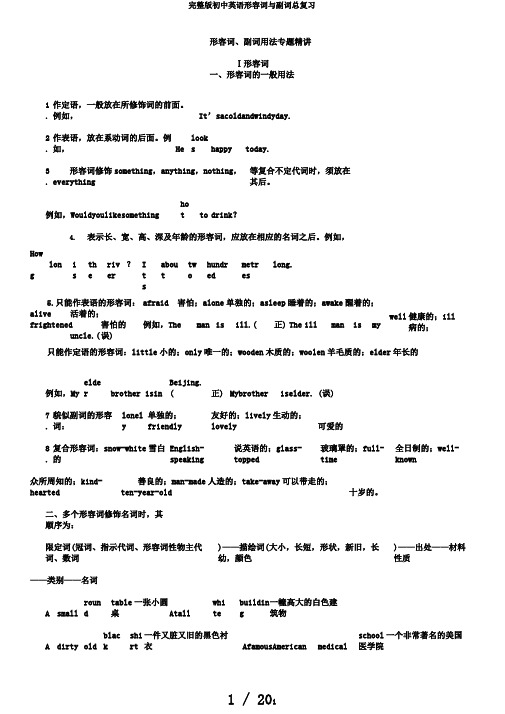
形容词、副词用法专题精讲Ⅰ形容词一、形容词的一般用法1 .作定语,一般放在所修饰词的前面。
例如,It’sacoldandwindyday.2 .作表语,放在系动词的后面。
例如,Helooks happy today.3 .形容词修饰something,anything,nothing,everything等复合不定代词时,须放在其后。
例如,Wouldyoulikesomething hot to drink?4.表示长、宽、高、深及年龄的形容词,应放在相应的名词之后。
例如,Howlon g istheriver?Itsabouttwohundredmetreslong.5.只能作表语的形容词:afraid 害怕;alone单独的;asleep睡着的;awake醒着的;alive 活着的;frightened 害怕的例如,The man is ill.( 正) The ill man is my uncle.( 误)well 健康的;ill病的;只能作定语的形容词:little小的;only唯一的;wooden木质的;woolen羊毛质的;elder年长的例如,My elder brother isinBeijing.(正)Mybrother iselder.(误)7 .貌似副词的形容词:lonely单独的;friendly友好的;lively生动的;lovely可爱的8 .复合形容词:snow-white雪白的English-speaking说英语的;glass-topped玻璃罩的;full-time全日制的;well-known众所周知的;kind-hearted善良的;man-made人造的;take-away可以带走的;ten-year-old十岁的。
二、多个形容词修饰名词时,其顺序为:限定词(冠词、指示代词、形容词性物主代词、数词)——描绘词(大小,长短,形状,新旧,长幼,颜色)——出处——材料性质——类别——名词A small roundtable一张小圆桌Atallwhitebuilding一幢高大的白色建筑物A dirty old blackshirt一件又脏又旧的黑色衬衣AfamousAmerican medicalschool一个非常著名的美国医学院三、形容词常用句型“It’s+adj.+of+sb.+不定式〞表示“某人(做某事)怎么样〞。
知识点形容词与副词总结
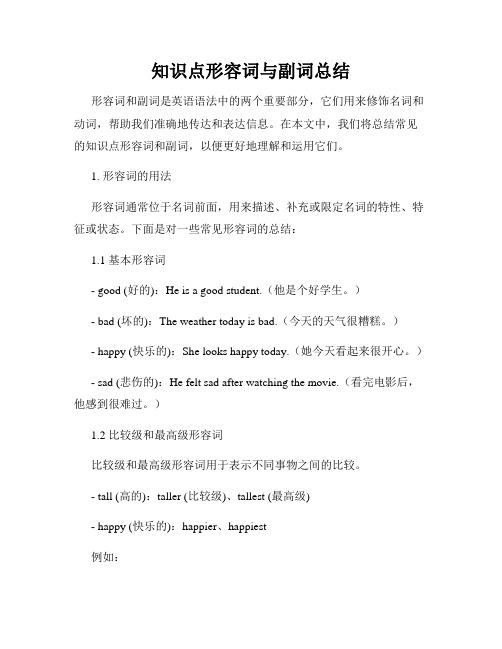
知识点形容词与副词总结形容词和副词是英语语法中的两个重要部分,它们用来修饰名词和动词,帮助我们准确地传达和表达信息。
在本文中,我们将总结常见的知识点形容词和副词,以便更好地理解和运用它们。
1. 形容词的用法形容词通常位于名词前面,用来描述、补充或限定名词的特性、特征或状态。
下面是对一些常见形容词的总结:1.1 基本形容词- good (好的):He is a good student.(他是个好学生。
)- bad (坏的):The weather today is bad.(今天的天气很糟糕。
)- happy (快乐的):She looks happy today.(她今天看起来很开心。
)- sad (悲伤的):He felt sad after watching the movie.(看完电影后,他感到很难过。
)1.2 比较级和最高级形容词比较级和最高级形容词用于表示不同事物之间的比较。
- tall (高的):taller (比较级)、tallest (最高级)- happy (快乐的):happier、happiest例如:- He is taller than his brother.(他比他的兄弟高。
)- She is the happiest person in the room.(她是房间里最快乐的人。
)1.3 泛指和特指形容词泛指形容词用于描述没有具体限制的事物,而特指形容词用于描述特定的事物。
- some (一些):He bought some apples.(他买了一些苹果。
)- this (这个):This book is interesting.(这本书很有趣。
)2. 副词的用法副词通常用来修饰动词、形容词或者其他副词,用来表达方式、时间、原因等。
2.1 副词修饰动词- slowly (慢慢地):He walks slowly.(他走得很慢。
)- quickly (快速地):She runs quickly.(她跑得很快。
形容词和副词用法知识点总结
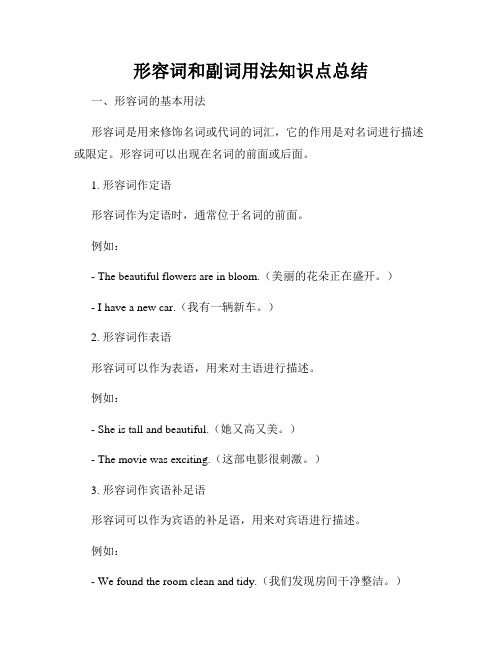
形容词和副词用法知识点总结一、形容词的基本用法形容词是用来修饰名词或代词的词汇,它的作用是对名词进行描述或限定。
形容词可以出现在名词的前面或后面。
1. 形容词作定语形容词作为定语时,通常位于名词的前面。
例如:- The beautiful flowers are in bloom.(美丽的花朵正在盛开。
)- I have a new car.(我有一辆新车。
)2. 形容词作表语形容词可以作为表语,用来对主语进行描述。
例如:- She is tall and beautiful.(她又高又美。
)- The movie was exciting.(这部电影很刺激。
)3. 形容词作宾语补足语形容词可以作为宾语的补足语,用来对宾语进行描述。
例如:- We found the room clean and tidy.(我们发现房间干净整洁。
)- He painted the wall red.(他把墙涂成了红色。
)二、副词的基本用法副词是用来修饰动词、形容词、副词或整个句子的词汇,它的作用是对动作、状态、程度等进行描述。
1. 副词修饰动词副词常常用来修饰动词,表示动作的方式、频率、时间等。
例如:- She speaks English fluently.(她流利地说英语。
)- He often goes swimming on weekends.(他经常在周末去游泳。
)2. 副词修饰形容词副词可以用来修饰形容词,表示程度或程度变化。
例如:- The weather is extremely hot today.(今天天气非常炎热。
)- She is quite tall for her age.(她相对于她的年龄来说很高。
)3. 副词修饰副词副词还可以用来修饰其他副词,表示程度、方式等。
例如:- He speaks English very fluently.(他非常流利地说英语。
)- She runs quite slowly.(她跑得相对较慢。
中考重点形容词与副词的运用

中考重点形容词与副词的运用形容词和副词是英语中非常重要的词性,它们可以用来修饰名词或动词,并提供更多的细节和信息。
在中考考试中,正确使用形容词和副词可以使作文更加生动、丰富,展示出学生的语言能力。
本文将介绍中考中常见的几种重点形容词与副词的运用。
一、形容词的运用1. 描述事物特征形容词可以用来描述事物的特征和性质,让读者更好地了解所描述的对象。
例如:- The beautiful flowers in the garden attracted many visitors.- The old man sat quietly on the park bench, lost in his thoughts.2. 表示情感和感受形容词也可以用来表示情感和感受,让读者更好地体验作者的情绪。
例如:- I felt extremely happy when I received the first prize.- The heartbreaking story made me feel sad and sympathetic towards the characters.3. 比较与级别形容词可以用来进行比较和表示程度的高低。
在写作中,我们可以使用原级、比较级和最高级来描述事物的差异。
例如:- He is taller than his brother.- Lily is the tallest girl in our class.二、副词的运用1. 描述动作方式副词可以用来描述动作的方式和方式,帮助读者更好地理解所描述的动作。
例如:- He walked slowly towards the door.- The baby smiled happily when he saw his mother.2. 表示程度和频率副词可以用来表示动作的程度和频率,进一步说明事物的情况。
例如:- I completely agree with your opinion.- She often goes to the library to study.3. 指示地点副词也可以用来指示地点,帮助读者更好地了解叙述中所提到的位置。
高中英语2025届高考语法复习形容词与副词知识讲解
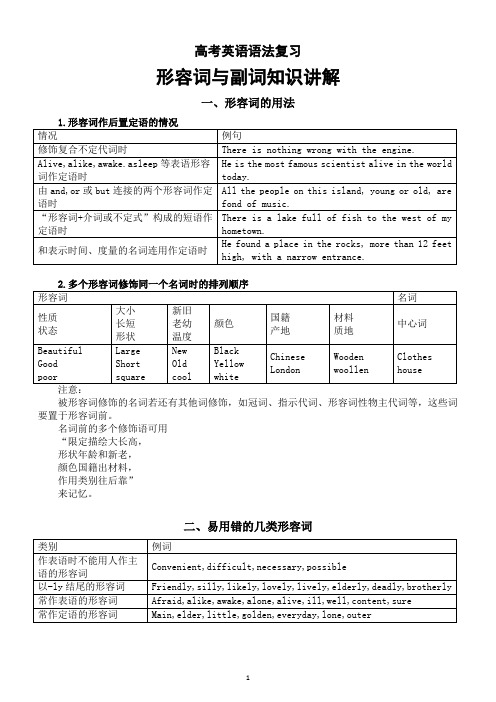
高考英语语法复习
形容词与副词知识讲解
一、形容词的用法
被形容词修饰的名词若还有其他词修饰,如冠词、指示代词、形容词性物主代词等,这些词要置于形容词前。
名词前的多个修饰语可用
“限定描绘大长高,
形状年龄和新老,
颜色国籍出材料,
作用类别往后靠”
来记忆。
二、易用错的几类形容词
三、形容词的比较等级
English is as interesting a subject as Chinese.
Which is the better of the two watches?
She is the taller of the two girls.
other或else把主语排除在比较对象之外;但如果不在同一范围比较则不需要用。
Susan is taller than any girl in her sister’s class.
四、副词的句法功能
五、副词的位置
六、副词比较等级的用法。
初中形容词副词知识点总结
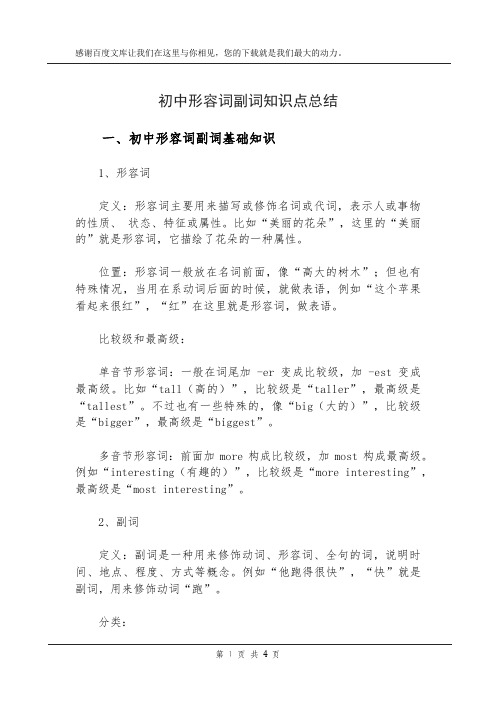
初中形容词副词知识点总结一、初中形容词副词基础知识1、形容词定义:形容词主要用来描写或修饰名词或代词,表示人或事物的性质、状态、特征或属性。
比如“美丽的花朵”,这里的“美丽的”就是形容词,它描绘了花朵的一种属性。
位置:形容词一般放在名词前面,像“高大的树木”;但也有特殊情况,当用在系动词后面的时候,就做表语,例如“这个苹果看起来很红”,“红”在这里就是形容词,做表语。
比较级和最高级:单音节形容词:一般在词尾加 -er变成比较级,加 -est变成最高级。
比如“tall(高的)”,比较级是“taller”,最高级是“tallest”。
不过也有一些特殊的,像“big(大的)”,比较级是“bigger”,最高级是“biggest”。
多音节形容词:前面加more构成比较级,加most构成最高级。
例如“interesting(有趣的)”,比较级是“more interesting”,最高级是“most interesting”。
2、副词定义:副词是一种用来修饰动词、形容词、全句的词,说明时间、地点、程度、方式等概念。
例如“他跑得很快”,“快”就是副词,用来修饰动词“跑”。
分类:时间副词:像“yesterday(昨天)”“now(现在)”“soon (不久)”等,它们主要用来表示时间概念。
地点副词:例如“here(这里)”“there(那里)”“everywhere(到处)”等,是用来描述地点的。
程度副词:如“very(非常)”“too(太)”“quite(相当)”等,用来表示程度的深浅。
方式副词:像“carefully(小心地)”“quickly(快速地)”“slowly(慢慢地)”等,是描述动作进行的方式。
副词的比较级和最高级:和形容词类似,单音节副词也是在词尾加 -er和 -est,多音节副词前面加more和most。
不过有些副词比较级和最高级是不规则的,比如“well(好地)”,比较级是“better”,最高级是“best”。
专项复习-形容词和副词

小升初语言知识运用形容词语副词一、形容词及其用法1.形容词修饰名词,说明事物或人的性质或特征,一般在句子里作定语和表语。
(1)作定语放在被修饰的名词前面,这类形容词有级的变化,可以用程度副词修饰,例如: nice,clean, good 等。
(2)作表语放在连系动词后面,表示状态。
这类形容词没有级的变化,也不可用程度副词修饰。
大多数以a开头的形容词都属于这一类。
例如: afraid 害怕的,alone 单独的,well(身体)好的,ill病的,alive活着的,asleep睡着的,awake醒着的等,请对比:He is an ill man. (×)The man is ill. (√)She is an afraid girl. (×)The girl is afraid. (√)2.形容词的用法(1)形容词的位置①形容词作定语修饰名词时,要放在名词的前面,例如:a big park 一个大公园the beautiful flowers 美丽的花朵②形容词修饰不定代词时,要放在不定代词的后面,例如:I have something important to tell you. 我有重要的事情要告诉你。
Is there anything new? 有什么新鲜事吗?③连系动词后要加形容词,例如:It became cloudy in the afternoon. 下午开始变得多云了。
The girl looks happy. 这个女孩看起来很高兴。
That sounds great. 听起来很棒。
连系动词包括: be, look, feel, taste, smell, sound, bee, go, get, turn, grow 等。
典型例题选词填空:(1)Her singing was _________ (love, lovely).(2) He spoke to me in a very _________ (friend, friendly) way.正确答案 (1) lovely (2) friendly解题思路有些词尾带 ly的单词是形容词, 例如: friendly, lovely, lonely, lively, ugly;有些以 ly结尾的单词既为形容词, 也为副词, 例如: daily, weekly, monthly, yearly, early 等。
2024中考英语形容词和副词用法总结
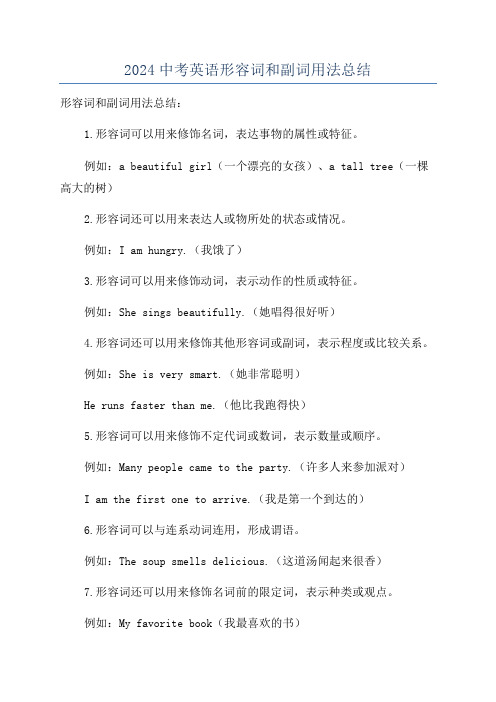
2024中考英语形容词和副词用法总结形容词和副词用法总结:1.形容词可以用来修饰名词,表达事物的属性或特征。
例如:a beautiful girl(一个漂亮的女孩)、a tall tree(一棵高大的树)2.形容词还可以用来表达人或物所处的状态或情况。
例如:I am hungry.(我饿了)3.形容词可以用来修饰动词,表示动作的性质或特征。
例如:She sings beautifully.(她唱得很好听)4.形容词还可以用来修饰其他形容词或副词,表示程度或比较关系。
例如:She is very smart.(她非常聪明)He runs faster than me.(他比我跑得快)5.形容词可以用来修饰不定代词或数词,表示数量或顺序。
例如:Many people came to the party.(许多人来参加派对)I am the first one to arrive.(我是第一个到达的)6.形容词可以与连系动词连用,形成谓语。
例如:The soup smells delicious.(这道汤闻起来很香)7.形容词还可以用来修饰名词前的限定词,表示种类或观点。
例如:My favorite book(我最喜欢的书)8.副词可以修饰动词、形容词或其他副词,表示动作的方式、程度或时间等。
例如:He speaks English fluently.(他流利地说英语)She is very tired.(她非常累)9.副词可以用来修饰整个句子或句子的其中一部分,表示说话人的态度或观点。
例如:Fortunately, we passed the exam.(幸运的是,我们通过了考试)Personally, I think she is right.(就我个人而言,我认为她是对的)需要注意的是,形容词和副词的用法需要根据具体语境和句子结构进行判断,不能一概而论。
同时,形容词和副词的形式有些相似,但其用法和词性是不同的,需要根据具体情况进行准确的用词。
- 1、下载文档前请自行甄别文档内容的完整性,平台不提供额外的编辑、内容补充、找答案等附加服务。
- 2、"仅部分预览"的文档,不可在线预览部分如存在完整性等问题,可反馈申请退款(可完整预览的文档不适用该条件!)。
- 3、如文档侵犯您的权益,请联系客服反馈,我们会尽快为您处理(人工客服工作时间:9:00-18:30)。
形容词和副词的用法考前
快速复习
The pony was revised in January 2021
形容词和副词的用法
一、形容词
1、形容词可分为两大类:描绘形容词和限定形容词。
描绘形容词是描写人或物的颜色、尺寸、形状、性质、状态等的形容词。
限定形容词用于限定被修饰词的数量、距离、所有关系等。
除了these和those外,形容词的单数与复数形式相同。
2、形容词的位置
修饰语一般应置于被修饰语之前,但当几个形容词修饰同一名词时,其排列顺序一般如下:
Example: that strong young Chinese swimmer
注意:形容词前有as, so, no, too, how等词时,不定冠词应置于形容词之后。
She is too kind a girl to refuse.
在下列情况下,修饰语应置于被修饰的名词后:
(1)名词之后的数量词+名词+old, long, wide等。
a boy six years old, a street two kilometers long
(2)为了加强语气或音调美,将描绘形容词置于名词之后。
He had a face thin and worn, but eager and resolute.
(3)something, anything,everyone, anybody…+形容词。
There′s nothing wrong with the electric cooker.
(4)作定语用的分词或形容词短语
The judge has talked to all the people involved.
3、“数词+名词”构成的形容词
(1)数词+名词,如 a two-week tour, a ten-page report等。
(2)数词+名词+形容词,如 a seven-year-old boy等。
(3)名词(无冠词)+基数词=the+序数词+名词,如
Unite 6=the Sixth Unite
(4)“数量词+复数名词”作主语,虽然是复数形式,但仍然用单数动词,作为一个单位来表示。
如果强调个别数,则须用复数动词。
Ten years is quite a long time to him.
Two months have passed since I last heard from my parents.
二、副词
1、副词的构成如下:
(1)本身就是副词,如very, now, there, quite等.
(2)有形容词后缀如-ly, 如happily, carefully等。
(3)有些副词与形容词同行,如early, high, long, fast, hard等。
注意:有些-ly结尾的词不是副词而是形容词,如manly, friendly, queenly等。
2、副词的位置
(1)修饰形容词和副词时,须放在被修饰词之前,如
The scenery around here is very beautiful.
(2)always, never, often, sometimes, ususlly等表示频率的副词在一般动词前,be 动词后,有助动词时,在助动词和动词之间。
He usually gets up early, but he got up late today.
I have never met him and I hope I will never meet him.
(3)有两个以上不同种类的副词作修饰语时,其顺序为地点(小地点+大地点)→状态→次数→时间(单位小的时间+单位大的时间)。
They arrived in Paris safely the other day.
(4)seldom, rarely, never等具有否定意义的频率副词置于句首时,助动词或be动词
须放在主语的前面(也叫倒装句),如
Never did I hear such a funny story=I never heard such a funny story.
3、几个特殊副词的用法
(1)enough须置于所修饰的形容词和副词之后;too须置于所修饰的形容词和副词之前.
She speaks English well enough to be an interpreter.
It,s too hot a day to work.
但enough修饰名词时须置于名词之前.
Have you got enough money for this microwave oven
(2)too…(for…)+不定式(to),作“太…而不能”解;enough+不定式,意思是“足够可以”,这一结构可转换成so…that结构。
The boy was still too young to go to school.
→He was so young that he could not go to school.
The man is rich enough to buy a Roll-Royce.
→He is so rich that he can buy a Roll-Royce.
(3)already用于肯定句,作“已经”解;yet用于否定句,作“还”解,用于疑问句作“已经”解,still作“仍然”解。
I have already seen film.
Have you seen the film yet
I still prefer tea to coffee.
(4)随着only和also在句中位置的改变,句意和语气也会改变。
Only Mr Li came to see me today.
Mr Li came to see only me today.
Mr Li came to see me only today. ?
三、形容词的比较等级
形容词比较等级的规则变化如下表:
四、形容词比较等级部分不规则变化表
五、形容词、副词比较等级的基本用法
形容词与副词都有三个比较等级。
1)原级常用于“as+原级+as”结构
He likes her as much as he likes his sister.
否定的原级用not as…as或not so …as,二者一般无甚区别。
He does not smoke so heavily as his brother.
2)比较级常用于“比较级+than” 结构.
He is taller than me.
否定比较与否定原级一样,也用not as(so)…as…结构,也可用less…than结构. This word is less frequent in British English than in American English. 3)两个人或物比较时,定冠词the+比较级表示最高级。
He is the taller of the two.
4)最高级常用于“the+最高级+比较范围”结构,比较范围为短语或从句。
He is the best picture in the hall.
5)含有否定词的比较级,如
(1)no less than=as much(or many)as “不亚于”
not less than=at least “至少”
(2)no less… than =as…as “和……一样”
not less+原级+than “至少不亚于”
(3)no more…than=not…any more than “和……一样不……”
not more…than=not so…as “不像……那样……”
(4)no more than=only “只不过”,言其少
not more than=at most “不多于”,“至少”
6)表示“几倍于”用twice(两倍),three times(三倍)+as…as, This book costs twice as much as the other one.
7)the+比较级……,the+比较级, 意思是“越……就越”,如:
The harder you work , the more you will learn.
8)比较结构之前可用程度状语加以修饰,如as…as前可用
almost,nearly,just(about),quite等词语修饰,如,
John is almost as tall as his father.
9)在more than结构之前可用far,(so)very much, (quite)a lot, a great deal, (just)a bit, still, far等词语修饰,如:
He speaks English a lot more rapidly than he does French.
10)比较级+and+比较级,作“越来……越”解,如:
The days are getting longer and longer.。
